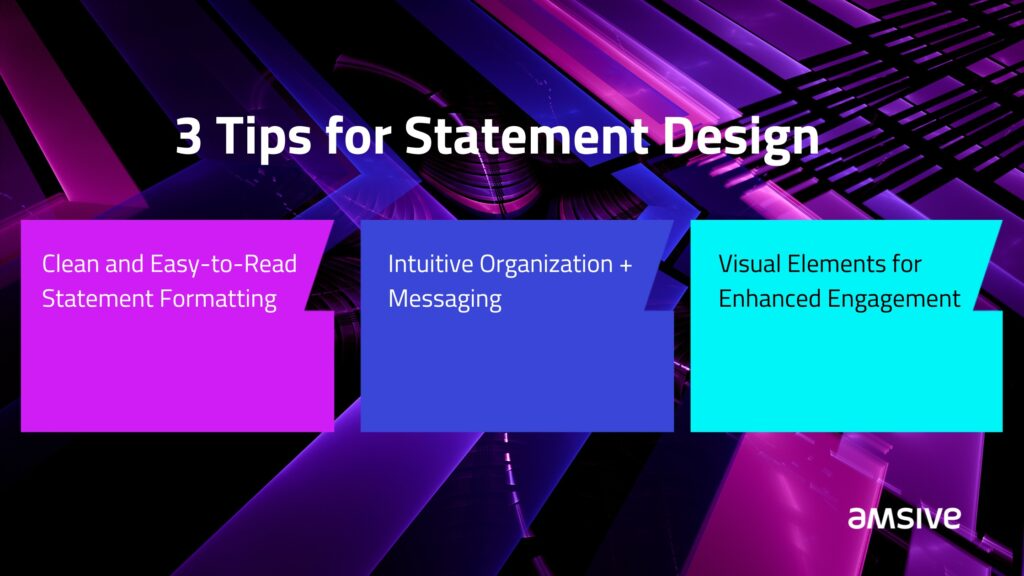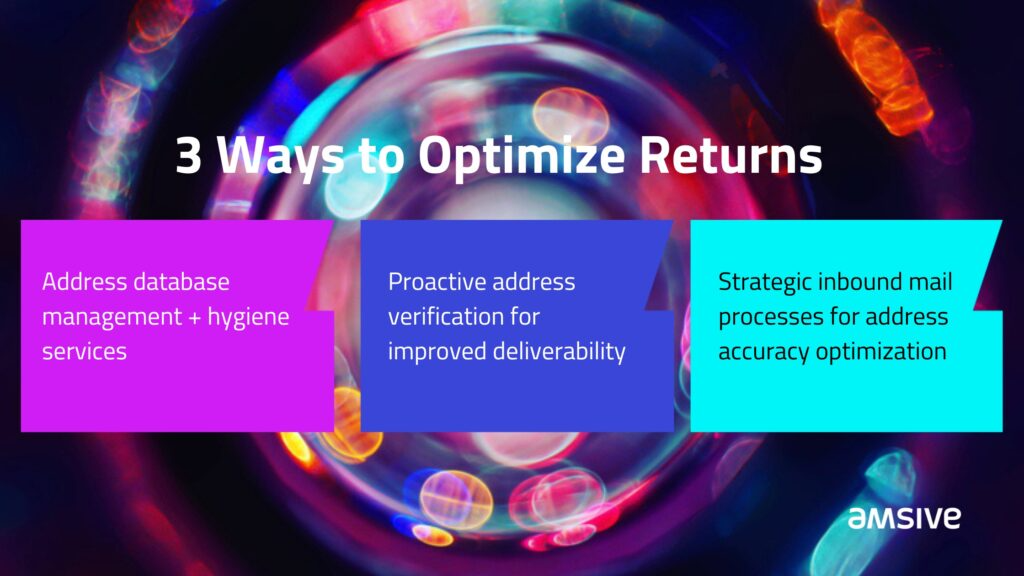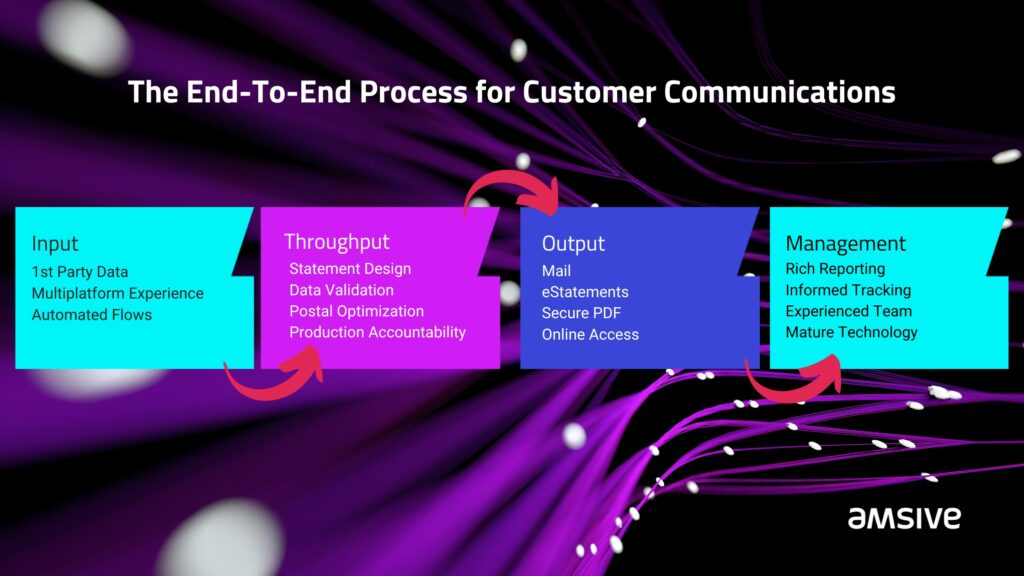
Customer communication is elemental to your customer experience. How well your customers receive their statements, bills, tax documents, and more impacts their connection with your company.
Mailed communications remain a primary touchpoint in this communication between customers and organizations. According to the latest Winterberry Group report, in 2023, U.S. marketers will invest $39.36 billion in their direct mail efforts, which include incorporating marketing messages into customer service and billing messages.
Within the future of the experience-driven market, customer communications represent a sizable opportunity for companies to improve satisfaction, loyalty, and ROI. Yet, maximizing the impact of your mailed communications requires a detailed roadmap to success. This includes factors like design, messaging, delivery timing, accuracy, and deliverability. Whether sending invoices, account updates, or other confidential information, efficient, secure customer communications that deliver on your brand promise takes careful attention and optimization from beginning to end.
Learn how to strategically approach your mailed communication, enhancing your brand’s reputation and building lasting relationships with your customers based on trust and reliability.
Jump To:
Companies can better utilize existing communications like printed statements to connect with customers. Tailoring messaging and offers based on customer data transforms mandatory mailings into engagement opportunities.

What’s included in customer communications? Here are some examples:
How can data-led decision-making drive the personalization of these communications? For example, a credit card statement could include personalized recommendations or incentives based on the customer’s purchase history and interests. An insurance renewal notice could have tailored upsell offers for additional coverage. Even transactional documents such as invoices can incorporate promotional messaging and marketing content.
The key is to leverage consumer intelligence to provide personalized value for each customer via your mail piece.
Advancing the design of your physical customer communications can significantly enhance your overall customer experience. You can create mail pieces that are more engaging, understandable, and effective for your audience. Thoughtful design paired with experimentation gives you the power to transform mundane mail into an impactful touchpoint. Here are three ways to improve your statement design.

When designing statements or other customer-facing documents, marketers must keep the end user’s experience in mind. By creating a clean and easy-to-read layout, with generous amounts of white space and a logical hierarchy of information, you can make it easier for customers to find what they need quickly. This not only improves comprehension but also helps highlight critical details that might otherwise get lost in a cluttered or confusing design.
In addition to a well-designed layout, it’s also vital to ensure that the content of your statements is organized clearly and logically. For example, companies should prominently display important information like account balances, due dates, or payment options so it’s easy to find. This can help reduce customer frustration and confusion, leading to a better overall experience.
Visual elements like charts, graphs, or infographics can help turn dry or complex information into more engaging and accessible content. For example, a pie chart might be used to display spending habits or account balances over time, while an infographic could outline the benefits of a particular service or product. By using visuals strategically, you can make your statements more memorable for customers.
Improving the design of physical customer communications enhances the overall customer experience by creating mail pieces that are more engaging, understandable, and effective. Three key ways to optimize statement design are clean formatting, intuitive organization and messaging, and strategic visual elements.
Utilizing A/B testing to experiment with different messaging, design, and delivery options can help optimize physical mail campaigns. Companies can test which version performs better by sending out two versions of the same mail piece with slight variations in content or design. This allows for data-driven decision-making on what works best for each customer segment.
For example, a bank could test two versions of a credit card offer mailer: one with a bold headline and another with an eye-catching graphic. The bank can determine which version is more effective by measuring response rates and adjusting future mailings accordingly.
By utilizing A/B testing, companies can continuously improve their physical mail campaigns and provide customers with more personalized experiences.

Advanced platforms enable companies to produce high volumes of accurate, customized communications while minimizing errors that frustrate customers. Automated monitoring provides proactive optimization, while efficient version control and approval workflows safeguard quality and compliance across evolving content. Leveraging robust technology solutions is key to delivering a consistently positive communications experience at scale. Here are three ways to optimize your current processes.
When dealing with large volumes of customized communications, it’s vital to have advanced platforms to ensure accuracy and quality. These platforms help catch errors, misprints, and other issues that frustrate customers. By automating specific processes and providing tools for proofreading and quality control, you can reduce the risk of mistakes and maintain high customer satisfaction.
Automated monitoring of delivery performance and regulatory compliance can help you avoid potential issues and proactively optimize your communications strategy. By tracking metrics like open rates, click-through rates, and bounce rates, you can identify areas for improvement and make adjustments as needed. And by ensuring compliance with relevant laws and regulations, you can reduce the risk of costly fines or legal action.
Effective version control and approval workflows are essential for managing changes to communications content. You can ensure that updates are accurate and timely by establishing clear guidelines for who can make changes, how they are made, and who needs to approve them. Efficient workflows can help prevent confusion or misunderstandings among customers and reduce the risk of errors or compliance issues.
Companies can optimize their communication processes through auditing automation to reduce mistakes, proactive delivery monitoring to identify improvements, and efficient version control workflows to manage accurate content changes. These advanced platform strategies minimize customer frustration while maximizing quality and compliance.
Optimizing your return mail process is crucial for improving deliverability, reducing undeliverable mail, and driving savings. This starts with proactive address database management using hygiene services to maintain accuracy. Additional strategies like real-time address verification and analyzing inbound mail patterns help continually update lists and maximize deliverability. With a strategic approach, you can reach more intended recipients and avoid wasted resources on undeliverable communications.

Maintaining updated address databases and using hygiene services can reduce the amount of returned mail and improve overall deliverability. Regularly cleaning and updating your mailing lists ensures that your communications reach their intended recipients and avoids wasting resources on undeliverable mail. As an added benefit, this saves costs associated with printing and postage.
Taking proactive steps to confirm recipient address changes and validate deliverability before printing can further reduce the amount of undeliverable mail. By verifying addresses in real time and making corrections or updates as needed, you can increase the chances that your communications will reach their intended destination. This can also help improve customer satisfaction by reducing delays or missed deliveries.
Implementing a strategic inbound mail processing system can provide valuable insights into address accuracy and help you continually optimize your mailing lists. By analyzing patterns in returned mail, you can identify common errors or issues that may be affecting deliverability. This information can then be used to make targeted improvements to your address databases and hygiene services, further reducing the risk of undeliverable mail.
Proactively managing address hygiene, verifying recipient details, and strategically processing returned mail optimizes deliverability by continually updating mailing lists to maximize accuracy. This comprehensive approach to optimizing the return mail process reduces undeliverable communications and saves costs.
Optimizing mailed customer communications requires a comprehensive, strategic approach – from design to delivery. Companies can transform mandatory mailings into an impactful brand touchpoint by focusing on elements like visual appeal, personalization, A/B testing, automation, and address hygiene. Partnering with experts who provide data-driven solutions, security protocols, and deliverability guarantees takes this optimization to the next level. Mailed communications represent a sizable yet often overlooked opportunity to drive loyalty, satisfaction, and ROI in today’s experience economy.
With the right strategy and execution, brands can tap into this potential and gain a competitive edge. The journey to success begins with recognizing mailed communications as a critical piece of the customer experience puzzle.

Partnering with the right physical mail provider is critical for companies looking to transform customer communications into a competitive advantage. When evaluating partners, prioritize those with extensive expertise in high-volume mail services, robust security protocols, proprietary platforms for efficiency, transparency for monitoring, and analytics teams for optimization. Additional security for regulated industries includes SOC2 Type II, PIC, and HIPAA compliance.
The ideal partner will have redundant nationwide facilities, enabling faster delivery and helping to take advantage of annual postal discounts across millions of personalized mail pieces. They should offer customized printing, mailing, and fulfillment services tailored to your regulatory needs. Comprehensive address hygiene and multichannel data quality monitoring are also essential for maximizing deliverability.
Most importantly, your partner should take a strategic, data-driven approach to continually improve mail design, tracking, and response rates based on analytics and customer feedback. This transforms communications into an impactful, cost-effective touchpoint that drives satisfaction and loyalty. By choosing a partner with specialized services and platform controls, you can optimize physical mail as a competitive advantage rather than a hassle. Working with experts pays dividends through enhanced customer experiences and bottom-line results.
Optimizing your customer communications strategy is only one part of a data-centric, performance-driven strategy, giving you the power to know and do more. Discover how to integrate emerging technologies into direct mail campaigns, or let’s talk about how to achieve more for your marketing – and your business.
The original version of this page was published at: https://www.amsive.com/insights/direct/4-ways-to-optimize-your-mailed-customer-communications-from-design-to-delivery/
At Amsive our mission is to make data-centric marketing a reality for more than just the largest companies. As a full-service agency, we bring our clients’ marketing to life by shaping strategy, id... Read more
Google’s replacement for Smart Shopping gives marketers and businesses new tools to better run their ad campaigns online.Performance Max is replacing Google Smart Shopping — ...read more
Online privacy is an increasing concern for consumers across the globe. People want to know if and how businesses are protecting their rights to privacy, and clear data privacy practices ...read more
Condensed from the presentation “When PPC Met SEO” from DigiMarCon Mid-South Digital Marketing Conference May 2023.As volatility increases within the search landscape, ...read more
Optimizing content for Google’s news surfaces can be a great way to reach more readers interested in timely stories and assert your brand’s topical authority online. As ...read more

Ask a Healthcare Lawyer: HIPAA Compliance for Healthcare Marketers
Your FAQs...Answered!